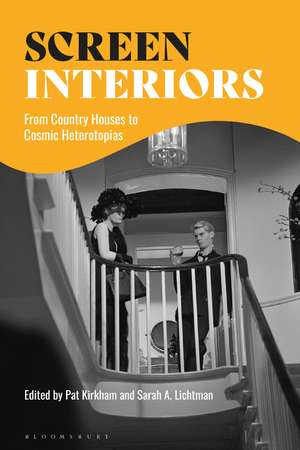Screen Interiors: From Country Houses to Cosmic Heterotopias
Editat de Pat Kirkham, Sarah A. Lichtmanen Limba Engleză Hardback – 5 mai 2021
Preț: 573.25 lei
Preț vechi: 818.55 lei
-30% Nou
Puncte Express: 860
Preț estimativ în valută:
109.69€ • 114.83$ • 90.76£
109.69€ • 114.83$ • 90.76£
Carte disponibilă
Livrare economică 15-29 martie
Preluare comenzi: 021 569.72.76
Specificații
ISBN-13: 9781350150584
ISBN-10: 1350150584
Pagini: 368
Ilustrații: 47 bw illus
Dimensiuni: 156 x 234 x 25 mm
Greutate: 0.75 kg
Editura: Bloomsbury Publishing
Colecția Bloomsbury Visual Arts
Locul publicării:London, United Kingdom
ISBN-10: 1350150584
Pagini: 368
Ilustrații: 47 bw illus
Dimensiuni: 156 x 234 x 25 mm
Greutate: 0.75 kg
Editura: Bloomsbury Publishing
Colecția Bloomsbury Visual Arts
Locul publicării:London, United Kingdom
Caracteristici
International spread of contributors from Australia, Belgium, Italy, the Netherlands, the UK and the USA
Notă biografică
Pat Kirkham is Professor of Design History at Kingston University, UK, Professor Emerita at the Bard Graduate Centre, USA, and Associate Research Fellow at the Cinema and Television Research History Centre, De Montfort University, UK.Sarah A. Lichtman is Assistant Professor of Design History at Parsons School of Design, USA.
Cuprins
List of FiguresAcknowledgementsIntroduction, Pat Kirkham (Kingston University, UK) and Sarah A. Lichtman (Parsons School of Design, USA)Section One: House and Home: Space, Comfort, Class, Gender, and Generation1. Comfort and the Domestic Interior in Soviet Fiction Cinema of the 1920s, Eleanor Rees (University of College London, UK)2. Furnishing I Love Lucy (1951-57), Marilyn Cohen (Parsons School of Design, USA)3. From the Country House Film to the House in the Country Film: Space, Class, and Generation, Christine Geraghty (University of Glasgow, UK)4. Space, Interiors, and 1980s Hollywood Teen Films, Patrick O'Neill (Kingston University, UK)Section Two: The Curated Home5. Mobilizing Material Culture: Collecting and Interiority in Luchino Visconti's Conversation Piece (1974), Shax Reigler (Architectural Digest, USA)6. From Sex to Narcissism: Understanding Minimalist Interiors in New York Films of the 1970s, Timothy M. Rohan (University of Massachusetts Amherst, USA)7. "Home furnishing takes a cue from Paris, too": The Fashion Professional at Work and Home in Postwar Hollywood Films, c. 1957-1961, Rebecca C. Tuite (Bard Graduate Center, USA)Section Three: Framing Interiors and Interiorities: Inside and Out8. Framing Interiorities: Interiors, Objects, and Hidden Desires in Billy Wilder's The Apartment (1960), Imma Forino (Politecnico di Milano, Italy)9. Frames, Veils, and Windows: Modern Cinematic Set Design in Early Russian Films by Evgenii Bauer, Maria Korolkova (University of Greenwich, UK)Section Four: Screening Queerness: Class, Gender, Sexual Orientation, Ambiguity, Authorit, and Power10. Interiors, Class, Perversity, and Ambiguity in The Servant (1963), Barry Curtis (Royal College of Art, UK)11. In Plain View: London Commercial Interiors as Queer spaces in Three 1960s British Films: Victim (1961), The Leather Boys (1964), and The Killing of Sister George (1968), Andrew Stephenson (University of East London, UK)12. Queer Interiors: Derek Jarman's Caravaggio (1986) and Edward II (1992), Adam Vaughan (University of Southampton, UK)Section Five: Horror and Homicide13. The Horror of the Homicidal Floor: Destabilized Elements of Interior Architecture, Alexandra Brown (Monash University, Australia) and Kirsty Volz (Queensland University of Technology, Australia)14. Designed to Destroy: Action Film Interiors and the Construction of Killscapes, Lennart Soberon (Ghent University, Belgium)Section Six: Living in Outer Space: Sci-Fi Interiors15. Visions of Home: Nostalgia and Mobility, Past, Present, and Future, in Serenity's Domestic Spaceship Interior, Sorcha O'Brien (Kingston University, UK)16. Cosmic Heterotopia: Banality and Disjunction in the Interiors of Passengers (2016), Ersi Ioannidou (Kingston University, UK) Author BiographiesIndex
Recenzii
This engaging and highly readable collection is the most comprehensive and scholarly exploration of the subject available, but it reads like a lively conversation among friends. From broad cultural themes to minute details, the essays included here answer myriad questions about how interiors, props, and visual cues shape our reactions to on-screen stories and images. An indispensable resource for anyone who has ever wondered how movies and TV shows are made and why they matter so much to us, this book is both a remarkable achievement and a delight to read.
Innovative and exciting-fascinating topics, new research, wide-ranging approaches, and fresh interpretations, marshalled with sophisticated editorial expertise. Screen Interiors is a much needed cross-disciplinary intervention that stakes out new ground in studies of film, television, and design.
Screen Interiors is a milestone in the literature on production design for film and television. Exploring how moving-image interiors reveal the inner lives of protagonists, the book offers multiple perspectives on a wide range of genres, countries, and time periods and investigates social themes such as gender, class, and sexuality. The book contributes insightful perspectives on popular films and their makers, while shedding light on productions and people. Equally valuable is the book's concise history of production design and its historiography.
Innovative and exciting-fascinating topics, new research, wide-ranging approaches, and fresh interpretations, marshalled with sophisticated editorial expertise. Screen Interiors is a much needed cross-disciplinary intervention that stakes out new ground in studies of film, television, and design.
Screen Interiors is a milestone in the literature on production design for film and television. Exploring how moving-image interiors reveal the inner lives of protagonists, the book offers multiple perspectives on a wide range of genres, countries, and time periods and investigates social themes such as gender, class, and sexuality. The book contributes insightful perspectives on popular films and their makers, while shedding light on productions and people. Equally valuable is the book's concise history of production design and its historiography.
